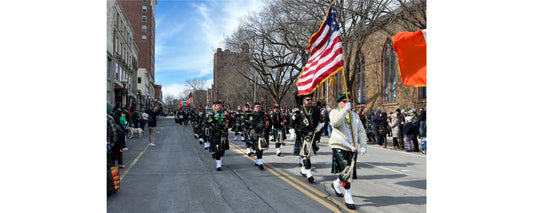Hashim Allah saw New Haven’s history of Hip Hop as it happened.
Allah did some DJ-ing, rapped a bit, wrote rhymes for others. But mostly he was just around. “I was the nerd of the bunch,” Allah smiles. “I thought of myself like UTFO, considered myself ‘the educated rapper.’” He’s still motivated by what he heard and learned in those days, and is now passing that education on to others. Last year Allah taught a class in “Hip Hop Literacy” at Wilbur Cross High School. This year, he’s started an online journalism project, Freedom Through Expression Radio, at Metropolitan Business Academy on Water Street.
sponsored by
By all accounts, Hip Hop in New Haven began with Tony Pearson, a.k.a. Mr. Magic. Pearson recorded the first Connecticut rap, “Rappin’ with Mr. Magic,” which includes shout-outs to dozens of Nutmeg State cities, in 1979. It begins:
Some people say that Connecticut can’t rock,
But I’m here to make you all hip and hop.
“Mr. Magic was my actual cousin,” Allah says. “As a youth, when I was not even old enough to get into clubs, I wanted to learn how to DJ. I stayed out of trouble so that I would be allowed to hang out with my cousin Tony.
“Tony became good at promoting shows, and I would get to DJ while he was running things. He had been doing disco, but Hip Hop was just starting to take off. I was younger, and I was originally from the Brooklyn area, so I naturally transitioned to Hip Hop.”
Tony Pearson—whose empire included a studio, a record label, and a distribution network which consisted of young Hashim Allah driving Magic Records’ or Tri-State Records’ latest 12” vinyl pressings to clubs and shops between here and Boston—continued to reference Connecticut on vital platters like “Gilligan’s Island to the Beat.”
Besides turning himself into Mr. Magic, Pearson (who’s still making local Hip Hop history as the host of the long-running public-access TV show Holla Back Video and an annual live Hip Hop Awards showcase) also created one of the first child rappers, Pookie Blow, who rapped the positivist, pro-education number “Get Up (And Go to School).” Pookie Blow (a.k.a. Jerry Pearson, Tony’s nephew) grew up to have an impressive military career. Other seminal figures in New Haven Hip Hop, also blood relations of Hashim Allah, were Sean Rhythm and DJ Demo. “DJ Demo really took off,” Allah says, “because he was the whole show. He would spin around, be cutting songs…”
Other local inspirations were local DJs Leo the Lion, Tommy DJ Pleasure, Doc Terror, DJ Ramzell and DJ Joey D. WNHU 88.7FM, the University of New Haven radio station, had a slew of shows touting the latest sounds. Cutler’s, Merle’s Record Rack and other independent record stores in the area loaned out singles and LPs to dues-paying members of the Connecticut DJ pool. Clubs which accommodated the Hip Hop crowd included Chico’s & Frankie’s, The Oasis, Monterey Café and Mr. Ray’s. The scene spread to the suburbs. “Hamden was a hot party zone,” Allah says.
Many future superstars from New York’s Hip Hop community would hop a train and hang out in New Haven, which some considered a safer and more laid-back scene than the New York boroughs. “We were all just working class slobs, hanging out,” Allah laughs, remembering when it was commonplace to run into Big Daddy Kane, Biz Markie and members of Run DMC, the Beastie Boys or Leaders of the New School on the streets of New Haven.
In the late ’70s and early ’80s, Allah says, “you could do parties anywhere: hotels, warehouses, grocery stores…” Clubs weren’t so competitive then, he explains. The club owners knew that the Hip Hop crowd would be traveling around a circuit of different venues, and cross-promoted accordingly. Allah recalls that the various music scenes—the waning disco scene and the burgeoning punk, new wave and Hip Hop scenes—interacted easily as well. The Hip Hop kids and punks got along particularly well, he remembers, because both scenes were “shunned. Nobody thought it would be what it is today.”
“There were parties at the clubs, parties at school.” More than anything, there were parties in city parks. “You’d go to City Hall, get a permit. You found your crew. Then you could go to your local park. The block parties were everywhere in New Haven—Ivory Street School, Davenport Park, Legion Avenue Park, Brookside Park and anywhere there was big basketball action.” Many of the parks are now the sites of schools and housing developments.
The block parties often involved DJ battles, with some contenders coming from other cities. “People would literally come to town carrying crates full of records, and head to the nearest park. It was competitive, but trying not to be violent.”
The violence and drugs and over-the-top boastfulness associated with the genre came later, Hashim Allah attests. His memory is of a scene where lifelong friendships were formed, where new talents were discovered and nurtured, where outdoor parties involved whole neighborhoods and lasted for entire days, where folks pooled their money and energy to help each other’s music get heard.
“Hip Hop was life-changing for us. This city was a beautiful place. As soon as you saw a van pull up on the grass, you knew the music was coming.”
Written and photographed by Christopher Arnott.








